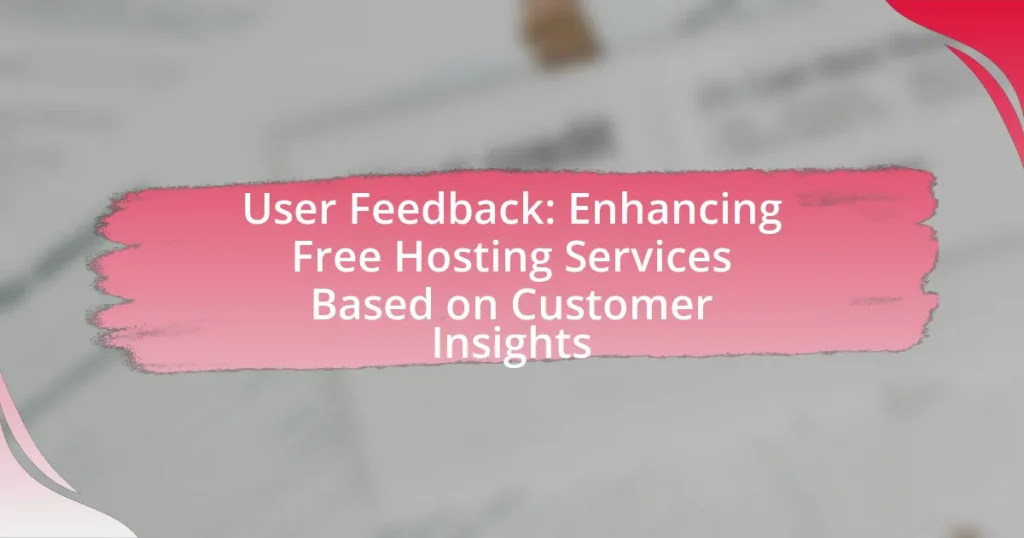Bandwidth limitations in free hosting solutions refer to the restricted data transfer allowed over a specified period, typically monthly, which can significantly affect website performance. These limitations can lead to slower loading times, increased latency, and potential downtime when the allocated bandwidth is exceeded. The article explores how bandwidth impacts website performance, user experience, and growth, while also discussing the reasons behind these limitations, common types, and strategies for optimizing bandwidth usage. Additionally, it highlights the implications for website owners, particularly in e-commerce, and offers best practices for managing bandwidth effectively.

What are Bandwidth Limitations in Free Hosting Solutions?
Bandwidth limitations in free hosting solutions refer to the restricted amount of data transfer allowed over a specified period, typically measured monthly. These limitations can significantly impact website performance, as exceeding the allocated bandwidth may result in throttling, reduced speeds, or even temporary suspension of the website. For instance, many free hosting providers impose caps ranging from 1 GB to 10 GB per month, which can be insufficient for websites with moderate to high traffic. This restriction is often implemented to manage server resources and ensure fair usage among users sharing the same infrastructure.
How do bandwidth limitations affect website performance?
Bandwidth limitations directly reduce website performance by restricting the amount of data that can be transmitted to users within a given time frame. When a website exceeds its bandwidth capacity, it may experience slower loading times, increased latency, or even downtime, as the server struggles to deliver content to multiple users simultaneously. For instance, a study by Akamai Technologies found that a 100-millisecond delay in load time can decrease conversion rates by 7%. This demonstrates that inadequate bandwidth can significantly hinder user experience and engagement, ultimately affecting the website’s effectiveness and reach.
What is the relationship between bandwidth and loading speed?
Bandwidth directly affects loading speed; higher bandwidth allows more data to be transmitted simultaneously, resulting in faster loading times for websites. When a website has limited bandwidth, it can become a bottleneck, causing delays as users attempt to access content. For instance, if a website has a bandwidth limit of 1 Mbps, it can only serve a limited amount of data at once, leading to slower loading speeds, especially during peak traffic times. Conversely, a website with higher bandwidth, such as 100 Mbps, can handle more simultaneous requests and deliver content more quickly, enhancing user experience.
How do bandwidth limitations impact user experience?
Bandwidth limitations significantly degrade user experience by causing slow loading times and interruptions in service. When users encounter restricted bandwidth, they often experience delays in accessing content, which can lead to frustration and increased bounce rates. Research indicates that a one-second delay in page load time can result in a 7% reduction in conversions, highlighting the critical nature of bandwidth in maintaining user engagement. Additionally, streaming services may buffer or fail to load entirely under low bandwidth conditions, further diminishing user satisfaction. Thus, inadequate bandwidth directly correlates with negative user experiences across various online platforms.
Why do free hosting solutions impose bandwidth limitations?
Free hosting solutions impose bandwidth limitations primarily to manage server resources and ensure fair usage among users. These limitations prevent any single user from monopolizing bandwidth, which could degrade performance for others sharing the same server. By capping bandwidth, providers can maintain a stable service level, as evidenced by the fact that many free hosting services operate on shared infrastructure, where resources are limited and must be allocated efficiently to accommodate multiple users simultaneously.
What are the cost implications of providing unlimited bandwidth?
Providing unlimited bandwidth typically results in higher operational costs for service providers due to increased infrastructure demands. The need for robust servers, enhanced network capacity, and advanced data management systems escalates expenses. For instance, a study by the International Telecommunication Union indicates that bandwidth costs can rise significantly as user demand increases, leading to potential overage fees or the necessity for costly upgrades to maintain service quality. Additionally, unlimited bandwidth offerings can attract a higher volume of users, further straining resources and necessitating additional investments in technology and support services.
How do bandwidth limitations help manage server resources?
Bandwidth limitations help manage server resources by controlling the amount of data that can be transmitted over a network within a specific time frame. This regulation prevents server overload, ensuring that resources are allocated efficiently among multiple users. For instance, when bandwidth is capped, it reduces the risk of congestion, allowing servers to maintain optimal performance levels and respond to requests without significant delays. Additionally, studies show that implementing bandwidth limits can lead to improved user experience, as it minimizes the likelihood of slowdowns during peak usage times, thereby enhancing overall service reliability.
What are the common types of bandwidth limitations in free hosting?
Common types of bandwidth limitations in free hosting include data transfer caps, throttling, and shared bandwidth. Data transfer caps restrict the amount of data that can be transferred to and from the server within a specified time frame, often measured monthly. Throttling occurs when the hosting provider intentionally slows down the connection speed after a certain usage threshold is reached. Shared bandwidth means that multiple users share the same bandwidth resources, which can lead to slower performance during peak usage times. These limitations are typically implemented to manage server load and ensure fair usage among users on free hosting plans.
What is a monthly bandwidth cap?
A monthly bandwidth cap is a limit set by internet service providers or hosting services on the amount of data that can be transferred to and from a user’s account within a month. This cap restricts the total volume of data that can be used, impacting the performance and accessibility of hosted content. For example, if a service imposes a cap of 100 GB, exceeding this limit may result in throttled speeds or additional charges. Bandwidth caps are commonly implemented in free hosting solutions to manage resources and ensure fair usage among users.
How does throttling work in free hosting solutions?
Throttling in free hosting solutions limits the amount of bandwidth or resources a user can consume to ensure fair usage among all users. This mechanism typically involves reducing the speed of data transfer once a user reaches a predefined limit, which can be set on a daily, weekly, or monthly basis. For instance, if a free hosting service allocates 1 GB of bandwidth per month, once a user exceeds this limit, their connection speed may be significantly reduced, often to a point where the website becomes slow or unresponsive. This practice helps maintain server performance and availability for all users, as free hosting services often operate on shared resources.

How can users navigate bandwidth limitations in free hosting solutions?
Users can navigate bandwidth limitations in free hosting solutions by optimizing their website content and utilizing caching techniques. By compressing images, minifying CSS and JavaScript files, and reducing the overall size of web pages, users can decrease the amount of bandwidth consumed. Additionally, implementing caching strategies, such as browser caching and server-side caching, allows frequently accessed data to be stored temporarily, reducing the need for repeated data transfers. According to a study by Google, optimizing images can reduce page load times by up to 80%, significantly lowering bandwidth usage.
What strategies can be employed to optimize bandwidth usage?
To optimize bandwidth usage, implementing data compression techniques is essential. Data compression reduces the size of files transmitted over the network, thereby decreasing the amount of bandwidth required. For instance, using formats like Gzip for web content can reduce file sizes by up to 70%, significantly lowering bandwidth consumption. Additionally, employing content delivery networks (CDNs) can distribute content closer to users, minimizing latency and bandwidth usage by caching static resources. Furthermore, optimizing images and using lazy loading can enhance performance by only loading images when they are in the viewport, which conserves bandwidth. These strategies collectively contribute to more efficient bandwidth utilization, particularly in environments with limitations, such as free hosting solutions.
How can image optimization reduce bandwidth consumption?
Image optimization reduces bandwidth consumption by decreasing the file size of images without significantly compromising quality. Smaller image files require less data to be transmitted over the internet, which directly lowers the amount of bandwidth used during loading. For instance, using formats like WebP or compressing images can reduce file sizes by up to 80% compared to unoptimized JPEGs or PNGs. This reduction in file size leads to faster loading times and less data usage, making it particularly beneficial for users on free hosting solutions with limited bandwidth.
What role does caching play in managing bandwidth?
Caching significantly reduces bandwidth usage by storing frequently accessed data closer to the user, minimizing the need for repeated data retrieval from the original server. When a user requests data, the cache serves it directly, which decreases the amount of data transmitted over the network. For instance, studies show that effective caching can reduce bandwidth consumption by up to 80% in web applications, as it limits the number of requests sent to the server. This reduction in data transfer not only optimizes bandwidth but also enhances load times and improves user experience, particularly in environments with bandwidth limitations, such as free hosting solutions.
What alternatives exist for users facing bandwidth limitations?
Users facing bandwidth limitations can consider several alternatives, including upgrading to a paid hosting plan, utilizing content delivery networks (CDNs), optimizing website content, and implementing caching solutions. Upgrading to a paid hosting plan typically provides higher bandwidth allowances, which can significantly enhance website performance. CDNs distribute content across multiple servers, reducing the load on a single server and improving access speed for users. Optimizing website content, such as compressing images and minimizing scripts, can decrease the amount of data transferred, effectively managing bandwidth usage. Caching solutions store frequently accessed data, reducing the need for repeated data transfers and improving load times. These strategies collectively help users manage bandwidth limitations effectively.
How do paid hosting solutions compare in terms of bandwidth?
Paid hosting solutions typically offer significantly higher bandwidth compared to free hosting options. While free hosting services often impose strict bandwidth limits, such as 1GB to 5GB per month, paid hosting plans can provide bandwidth ranging from 10GB to unlimited, depending on the provider and plan selected. This increased bandwidth allows for better performance, accommodating more traffic and larger data transfers without throttling or downtime, which is crucial for businesses and websites with high visitor volumes.
What are the benefits of upgrading to a higher bandwidth plan?
Upgrading to a higher bandwidth plan significantly enhances internet performance, allowing for faster data transfer rates and improved user experience. This upgrade facilitates smoother streaming of high-definition content, quicker downloads, and more reliable connections for multiple users simultaneously. According to a study by the Federal Communications Commission, higher bandwidth can reduce latency and buffering, leading to a more efficient online experience, especially for activities such as video conferencing and online gaming.

What are the implications of bandwidth limitations for website owners?
Bandwidth limitations significantly impact website owners by restricting the amount of data that can be transferred to and from their sites. This constraint can lead to slower loading times, which negatively affects user experience and can result in higher bounce rates; studies show that a one-second delay in page load time can lead to a 7% reduction in conversions. Additionally, exceeding bandwidth limits can cause websites to go offline temporarily, disrupting service and potentially harming the site’s reputation. Furthermore, website owners may incur additional costs if they need to upgrade their hosting plans to accommodate higher traffic, which can strain budgets, especially for small businesses or personal projects.
How can bandwidth limitations affect website growth?
Bandwidth limitations can significantly hinder website growth by restricting the amount of data that can be transmitted to users. When a website exceeds its bandwidth cap, it may experience slow loading times or become temporarily inaccessible, leading to a poor user experience. Research indicates that 47% of users expect a webpage to load in two seconds or less, and a delay of just one second can reduce conversions by 7%. Consequently, if a website frequently encounters bandwidth issues, it may lose potential visitors and customers, ultimately stunting its growth and online presence.
What challenges do bandwidth limitations pose for e-commerce sites?
Bandwidth limitations pose significant challenges for e-commerce sites by restricting the amount of data that can be transmitted to and from the server. This restriction can lead to slow loading times, which negatively impacts user experience; studies show that a one-second delay in page load time can result in a 7% reduction in conversions. Additionally, limited bandwidth can cause website downtime during peak traffic periods, leading to lost sales opportunities and diminished customer trust. Furthermore, inadequate bandwidth can hinder the ability to display high-quality images and videos, which are crucial for engaging customers and showcasing products effectively.
How do bandwidth limitations influence content delivery strategies?
Bandwidth limitations significantly influence content delivery strategies by necessitating the optimization of data transfer methods to ensure efficient user experience. When bandwidth is restricted, content delivery networks (CDNs) often prioritize the compression of files and the use of adaptive bitrate streaming to reduce the amount of data transmitted. For instance, research indicates that optimizing images and using formats like WebP can decrease load times by up to 80%, which is crucial in low-bandwidth scenarios. Additionally, strategies such as caching frequently accessed content closer to users can mitigate the impact of bandwidth constraints, enhancing accessibility and performance.
What best practices should website owners follow regarding bandwidth?
Website owners should optimize their content and implement caching strategies to effectively manage bandwidth. Optimizing content includes compressing images and using efficient coding practices, which can significantly reduce file sizes and loading times. For instance, using image formats like WebP can decrease image size by up to 30% compared to traditional formats without sacrificing quality. Implementing caching strategies, such as browser caching and server-side caching, allows frequently accessed data to be stored temporarily, reducing the need for repeated data transfers. According to Google, effective caching can improve load times by 2-3 seconds, which directly impacts bandwidth usage. Additionally, monitoring bandwidth usage through analytics tools helps identify peak usage times and allows for adjustments to be made proactively.
How can regular monitoring of bandwidth usage help?
Regular monitoring of bandwidth usage helps identify consumption patterns and potential bottlenecks in network performance. By tracking bandwidth, organizations can pinpoint peak usage times and determine if their current hosting solution meets their needs. For instance, a study by the International Journal of Computer Applications found that 70% of businesses that monitored their bandwidth usage were able to optimize their network performance and reduce costs by reallocating resources effectively. This proactive approach allows for timely adjustments, ensuring that free hosting solutions do not exceed their limitations, which can lead to service interruptions or degraded performance.
What tools are available for tracking bandwidth consumption?
Tools available for tracking bandwidth consumption include network monitoring software such as PRTG Network Monitor, SolarWinds Bandwidth Analyzer, and NetFlow Analyzer. These tools provide real-time data on bandwidth usage, allowing users to identify which applications or devices are consuming the most bandwidth. For instance, PRTG Network Monitor can track bandwidth usage across multiple devices and generate detailed reports, while SolarWinds Bandwidth Analyzer offers insights into traffic patterns and performance metrics. NetFlow Analyzer utilizes flow data to provide visibility into bandwidth consumption, helping users optimize their network performance.
What are the common troubleshooting tips for bandwidth issues?
Common troubleshooting tips for bandwidth issues include checking network congestion, testing internet speed, restarting the router, and limiting the number of connected devices. Network congestion can occur during peak usage times, affecting overall bandwidth availability. Testing internet speed using tools like Speedtest can help identify if the connection is slower than expected. Restarting the router can resolve temporary connectivity issues and refresh the connection. Limiting the number of connected devices can reduce bandwidth strain, as each device consumes a portion of the available bandwidth. These steps are effective in diagnosing and resolving common bandwidth problems.















